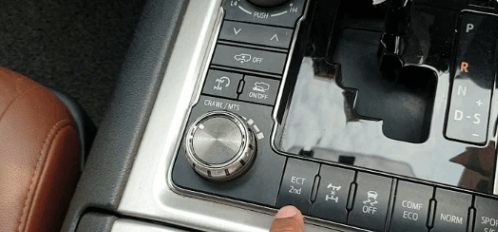The 4Runner is a popular SUV known for its reliability and off-road capabilities. One of the features that many 4Runner owners rely on is the ECT Power mode.
However, there may be instances where the ECT Power mode does not function as expected. In this article, we will explore some common reasons why ECT Power may not be working in a 4Runner and discuss potential solutions.
More Read – 4runner ECT Power – What it Does & When to Use it
Why Is My 4runner Ect Power Not Working?
The ECT (Electronically Controlled Transmission) Power button in a Toyota 4Runner is designed to modify the transmission shift points for more aggressive driving.
If you’re experiencing issues with the ECT Power not working, there are a few potential reasons for this problem:
1. Check ECT Power Button and Indicator Light
The first step is to make sure the ECT Power button is engaged and that the indicator light is functioning correctly. The ECT Power button is typically located on the center console or dashboard and should be illuminated when activated.
If the button does not respond when pressed or the indicator light does not turn on, there may be an issue with the button itself or the electrical connection.
2. Check for Faulty Fuse
A blown fuse can also cause the ECT Power mode to stop working. To check for a faulty fuse, locate the fuse box in your 4Runner. Refer to the owner’s manual or look for a diagram on the inside of the fuse box cover to identify the fuse related to the ECT Power mode.
If the fuse appears to be blown, replace it with a new one of the same amperage rating. However, if the new fuse also blows, there may be an underlying electrical issue that requires further investigation by a professional mechanic.
3. Verify Transmission Fluid Level and Condition
Insufficient or contaminated transmission fluid can affect the performance of the ECT Power mode. Check the transmission fluid level using the dipstick located under the hood.
Ensure that the fluid is at the appropriate level and appears clean and clear. If the fluid is low or has a burnt odor, it may be necessary to top it off or replace it entirely. A professional mechanic can help you with this process if needed.
4. Throttle Position Sensor (TPS) Calibration
The ECT Power mode relies on the accurate input from the throttle position sensor (TPS). If the TPS is not calibrated correctly, it may lead to issues with the ECT Power mode.
To recalibrate the TPS, you may need to consult the vehicle’s service manual or take it to a reputable mechanic who has the necessary diagnostic tools. They will be able to perform the calibration and ensure the TPS is functioning properly.
5. Check for Error Codes
If the ECT Power mode continues to malfunction, it may be beneficial to check for any error codes using an OBD-II scanner. The OBD-II port is typically located under the dashboard on the driver’s side. Connect the scanner to the port and retrieve any error codes that may be stored in the vehicle’s computer system.
These codes can provide valuable insight into the specific issue causing the ECT Power mode to not work. Once you have the error codes, consult the appropriate repair manual or seek professional help to diagnose and address the problem.
6.Consult a Professional Mechanic
If you’re unable to identify or resolve the issue on your own, it’s recommended to consult with a professional mechanic or take your 4Runner to a Toyota dealership. They have the expertise and tools to diagnose and fix complex automotive issues.
Remember that the information provided here is general in nature, and specific diagnostics would require a hands-on inspection by a qualified automotive professional. If your vehicle is still under warranty, it’s advisable to contact the dealership for assistance.

How Do I Troubleshoot The Ect Power Issue In My 4runner?
Troubleshooting the ECT (Electronically Controlled Transmission) Power issue in your Toyota 4Runner involves a systematic approach to identify and address potential problems. Here’s a step-by-step guide:
Check the ECT Power Switch:
Start by inspecting the ECT Power button itself. Ensure that it’s not physically damaged and that it engages properly when pressed. If the button is faulty or unresponsive, it may need to be replaced.
Inspect Fuses:
Locate the fuse box in your vehicle and check for any blown fuses related to the transmission or ECT system. Refer to your vehicle’s owner’s manual to identify the specific fuse(s) associated with the ECT Power function. If you find a blown fuse, replace it with one of the same amperage.
OBD-II Diagnostics:
Use an OBD-II scanner to check for any error codes stored in the vehicle’s computer system. Look for codes related to the transmission or engine control module. The codes can provide valuable information about the nature of the problem.
Test ECT Power in Different Driving Conditions:
Take the vehicle for a test drive in various conditions, including stop-and-go traffic and highway driving. See if the ECT Power mode engages in specific situations. This information can help pinpoint whether the issue is intermittent or related to certain driving conditions.
Transmission Fluid Level and Condition:
Check the transmission fluid level and condition. Low fluid levels or dirty/fluid in poor condition can affect the transmission’s performance. If the fluid is low, top it off with the recommended type of transmission fluid. If it’s dirty, consider having a transmission fluid flush or change.
Consult Professional Mechanics:
If you are unable to identify the issue through the above steps, it’s recommended to consult with a professional mechanic or take your 4Runner to a Toyota dealership. They can perform more advanced diagnostics, such as checking sensors, the transmission control module, and other components.
ECM and TCM Inspection:
The Engine Control Module (ECM) and Transmission Control Module (TCM) play crucial roles in the ECT Power function. If there are issues with these modules, it can affect the transmission’s performance. Professional mechanics can use specialized equipment to diagnose problems with these modules.
Check for Technical Service Bulletins (TSBs):
Check if there are any relevant TSBs issued by Toyota for your model and year. TSBs often provide information about known issues and recommended solutions.
Frequently Asked Questions On Troubleshoot 4runner Ect Power: Restore Optimal Performance
What Are The Symptoms Of A Faulty Ect Power System?
Symptoms of a faulty ECT Power system include sluggish acceleration, decreased engine responsiveness, and a lack of power when driving uphill.
Can I Drive My 4runner Without Ect Power Functioning?
Yes, you can drive your 4Runner without ECT Power functioning. The vehicle will operate in normal mode without any adverse effects.
How Can I Reset The Ect Power In My 4runner?
To reset the ECT Power, turn off the engine, wait for a few minutes, then start the vehicle again. This may reset the system and resolve the issue.
When Should I Seek Professional Help For My Ect Power Issue?
If troubleshooting steps don’t resolve the ECT Power issue, it’s recommended to seek professional help from a certified mechanic or Toyota dealership for further diagnostics and repair.
Conclusion
The ECT Power mode is a valuable feature in the 4Runner, enhancing its performance and responsiveness. However, if you find that the ECT Power mode is not working as expected, there are several potential causes to consider. By following the steps outlined in this article, you can troubleshoot and identify the issue, allowing you to get your ECT Power mode back up and running in no time.





